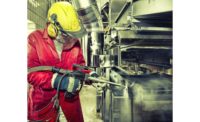Supplier Perspectives
Dry ice cleaning: The clean in place solution

Dry ice cleaning is similar in concept to sand, bead and soda blasting in that it cleans surfaces using a media accelerated in a pressurized air stream. But, dry ice cleaning uses solid CO2 pellets or MicroParticles, accelerated to high velocities to impinge on the surface and clean it. The particles sublimate upon impact, lifting dirt and contaminants off the underlying substrate without damage.
Traditional cleaning methods are time consuming, labor intensive and costly. Manual scraping or scrubbing with wire brushes and water or chemicals can consume many hours and result in extended downtime and can cause damage to equipment, shortening asset life and/or making it less productive. Dry ice cleaning makes cleaning easier, more complete and enables food manufacturing or packaging facilities to quickly and easily clean a number of different surfaces and get them back into production immediately (no rinsing, drying and less disassembly).
The unique characteristics of dry ice make it the perfect media for a clean-in-place process.
No secondary waste
Cleaning with dry ice enhances sustainability efforts. It sublimates (turns from solid to gas) upon impact with the surface being cleaned, which means no secondary waste, no residue and no moisture is being generated. This eliminates the added costs of extra cleanup, disposing of secondary waste streams and additional cleaning preparation, such as masking delicate sensors or wrapping electronic components prior to cleaning.
The cleaning process does not use water, which allows equipment to be cleaned while online and still operating. Because it is non-conductive, dry ice cleaning allows for electrical equipment to be safely cleaned.
Non-abrasive
Dry ice is a very soft media and can clean sensitive electronic equipment, such as printed circuit boards, without etching, profiling or changing surface dimensions.
Non-toxic
Dry ice is a food-grade media and is EPA, FDA and USDA approved for use around food manufacturing. It is colorless, tasteless, odorless and non-toxic. It allows for the elimination of environmentally harmful cleaning chemicals and eliminates worker exposure to hazardous cleaning agents. It also does not produce any toxic waste that must be disposed of.
Dry ice cleaning machines are very mobile and can be rolled right up to the machine being cleaned to maximize in situ cleaning capability. Various hoses and nozzles can also be fitted to ensure that no clean is out of reach. It can also be easily integrated into manufacturing processes for different levels of automation.
Utilizing dry ice cleaning in a clean-in-place process can result in cost savings, improved productivity, the extension of equipment life and improved worker safety.
Reduce costs
Dry ice cleaning reduces labor costs because it can be done quickly by one person and in significantly less time than conventional manual labor. This enables a cleaner clean even in situations that are difficult or unpopular to clean by hand with conventional methods.
Improve Productivity
It helps to reduce shut down times, as equipment can be cleaned while hot and online. By cleaning equipment in less time, facilities are able to get more production cycles from existing equipment. Preventive maintenance or spot cleaning can also be done more frequently without impacting production.
Prolong Life of Equipment
Dry ice cleaning is a dry process that is non-abrasive and non-conductive; meaning it won’t damage equipment and is safe for most surfaces, including electrical components.
Improve Worker Safety
Dry ice cleaning eliminates exposure to toxic cleaning materials. The process also eliminates repetitive motions of hand cleaning or scrubbing, chiseling or activities that require pounding, sanding or scraping. NP
Looking for a reprint of this article?
From high-res PDFs to custom plaques, order your copy today!








